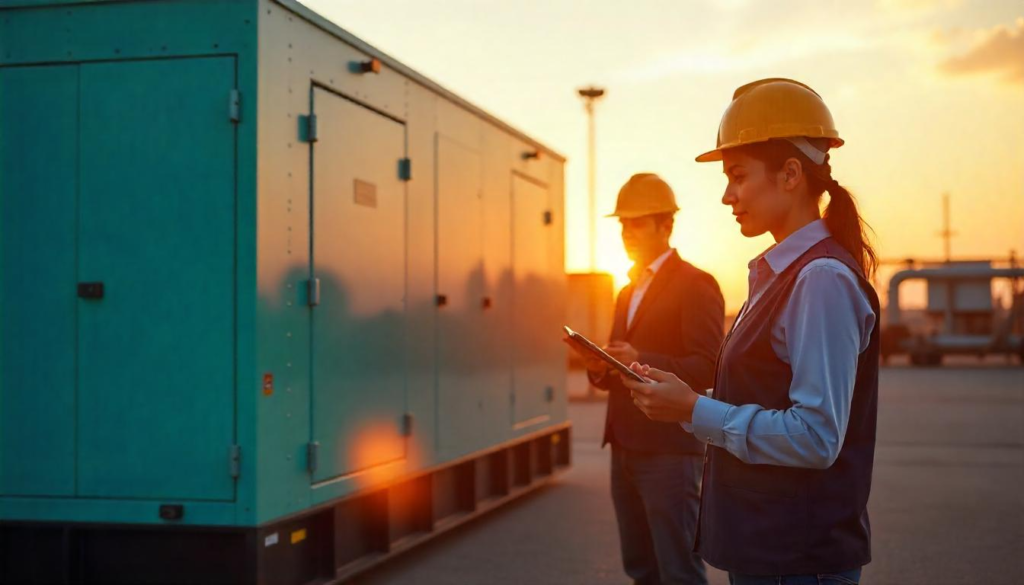Let’s face it—industrial generators aren’t exactly the most thrilling topic. But when the power goes out, and your factory floor grinds to a halt or your hospital’s life-saving equipment stops humming, suddenly generators become the superheroes of the day. Picking the right one doesn’t have to feel like solving a rocket science equation. Let’s break it down into bite-sized, human-friendly steps.
Figure Out How Much Power You Actually Need (Generator for Industrial Use)
Imagine hosting a party and realizing your outlets can’t handle the blender, lights, and the speaker system. Generators for industrial use work the same way—they need to handle your biggest power hitters.
- Do the math: List every machine, light, and system that needs backup power. Add up their wattage (check nameplates or manuals). Don’t forget:
- Surge power: Motors and compressors are like toddlers—they throw tantrums (read: need 2–3x more power) when starting up.
- Future-proofing: Will you add more equipment next year? Leave room to grow (aim for 20% extra capacity).
Pro Tip: If math isn’t your thing, hire an electrician for a “load bank test.” It’s like a dress rehearsal for your generator for industrial use.

Fuel Type—The “Gas vs. Diesel” Debate
Generators for industrial use are like cars: some guzzle diesel, others sip natural gas, and a few are eco-friendly hybrids. Here’s the lowdown:
- Diesel: The workhorse.
- 👍 Reliable, durable, and great for remote sites.
- 👎 Smoggy fumes and strict storage rules (think fire marshals).
- Natural Gas: The “cleaner” cousin.
- 👍 Connects to city lines (no storage tanks!) and eco-friendlier.
- 👎 Useless during gas line breaks (thanks, earthquakes).
- Hybrids: The hipster option.
- Solar panels or batteries paired with diesel/gas. Perfect if your CEO’s obsessed with sustainability.
Best for:
- Construction sites in the boonies → Diesel.
- City hospitals → Natural gas or hybrids.

Pick Your Generator’s Personality
Not all generators for industrial use are created equal. Meet the three main types:
- The Night Owl (Standby Generator)
- Sits quietly, waiting for a power outage.
- Automatically kicks in within seconds.
- Perfect for: Hospitals, data centers, or anyone who hates downtime.
- The Marathon Runner (Prime/Continuous Generator)
- Runs 24/7, no breaks. Built for rugged, off-grid sites like mines or oil rigs.
- Warning: These cost more upfront but save you during long hauls.
- The Road Tripper (Portable Generator)
- Small, mobile, and temporary. Great for construction sites or festivals.
- Downside: Not weatherproof. A monsoon will turn it into a paperweight.
Must-Have Features for Your Generator for Industrial Use
Think of this like shopping for a smartphone. Do you need the “Pro Max” model or just the basics?
- Automatic Transfer Switch: No one wants to sprint outside to flip a switch during a storm. This does it for you.
- Weather Armor: If your generator for industrial use lives in a hurricane zone or Sahara-like heat, buy one with a heavy-duty enclosure.
- Quiet Mode: Generators are loud. Look for models under 75 decibels (about as noisy as a vacuum cleaner).
- Wi-Fi Wizardry: Get one that texts you when fuel’s low or a part’s about to break. Yes, that’s a real thing.

Don’t Get Blindsided by Hidden Costs (Generator for Industrial Use)
That 20k generator for industrial use might actually cost 20k generator for industrial use might actually cost 50k over 5 years. Here’s why:
- Fuel Bills: Diesel’s pricier but lasts longer. Natural gas is cheaper but burns faster.
- Maintenance: Diesel generators need TLC (oil changes, filter swaps). Natural gas? Less fuss.
- Warranty Wars: Skip brands with flimsy 1-year warranties. Aim for 5+ years and 24/7 support.
Real-Life Win: A brewery saved $12k/year by switching to a bi-fuel generator for industrial use. Beer never tasted so cost-effective.
Rules, Regulations, and Red Tape (Generator for Industrial Use)
Nobody likes paperwork, but ignoring regulations can shut you down faster than a blown fuse.
- Emissions: In the U.S., meet EPA Tier 4 standards. In Europe, aim for EU Stage V.
- Safety: Follow NFPA 110 (translation: don’t install a generator for industrial use next to a fireworks factory).
- Local Laws: Check noise ordinances, fuel storage permits, and zoning rules.
Find a Supplier Who Won’t Ghost You
A generator for industrial use is a long-term relationship. Red flags to avoid:
- 🚩 No certifications (ISO 8528 is the gold standard).
- 🚩 Zero customer reviews or vague promises.
- 🚩 “Sorry, we don’t have spare parts for 6 months.”
Green Flags:
- ✅ Case studies from your industry.
- ✅ Local technicians who can fix issues STAT.
Mistakes That’ll Haunt You
- Underestimating power needs: Like buying a scooter to tow a semi-truck.
- Ignoring fuel logistics: Storing diesel in a tiny urban lot? Good luck.
- Cheaping out: A 10k generator for industrial use that dies in a year costs more than a 10k generator for industrial use that dies in a year costs more than a20k one that lasts a decade.
Choosing a generator for industrial use isn’t about impressing engineers with jargon—it’s about keeping your business running when the grid taps out. Whether you’re powering a factory, a hospital, or a rock concert, take it step by step. And if you’re stuck? Call in a pro. Your sanity (and profit margins) will thank you.
